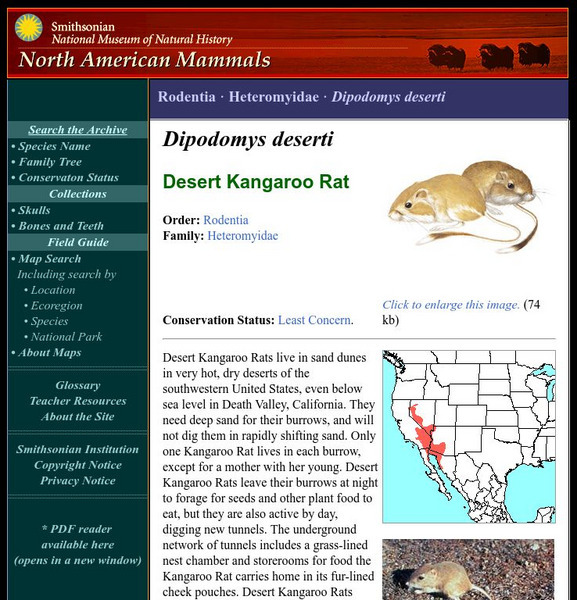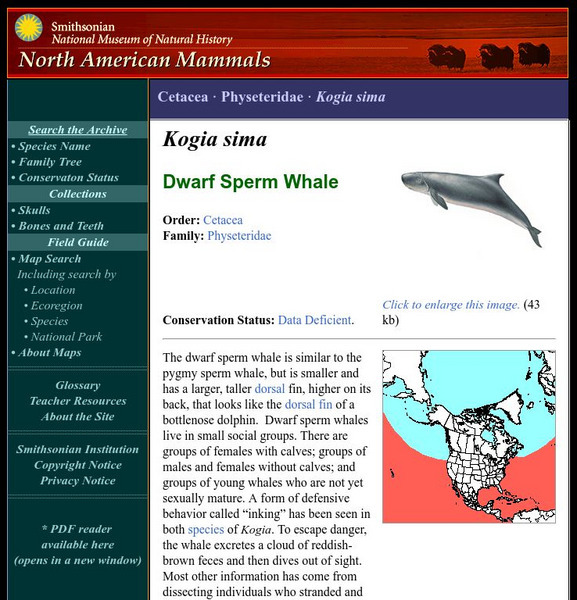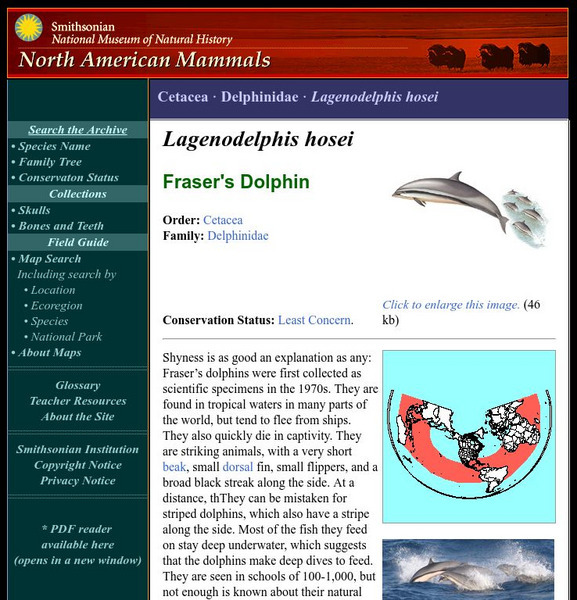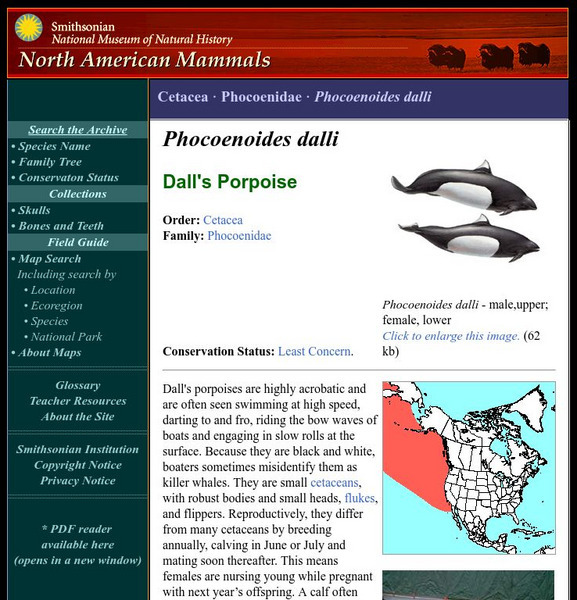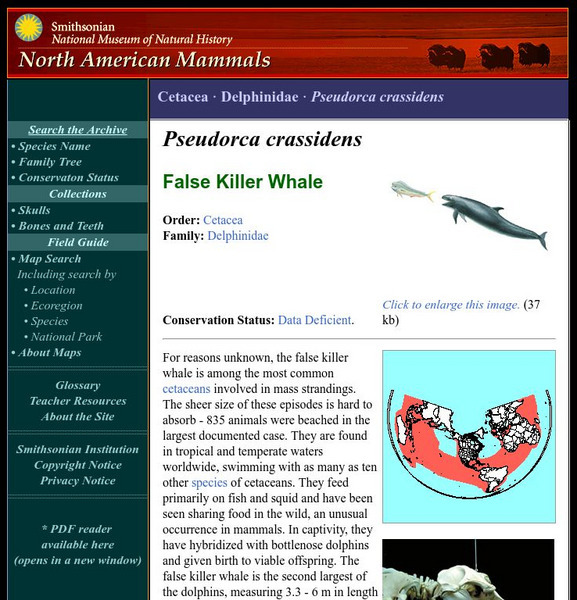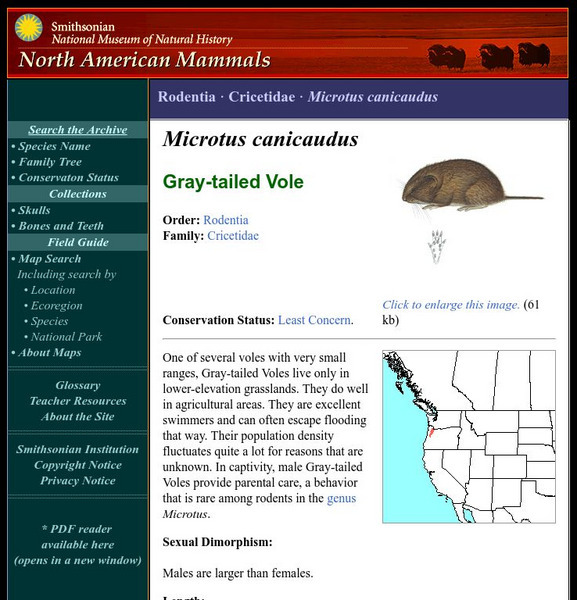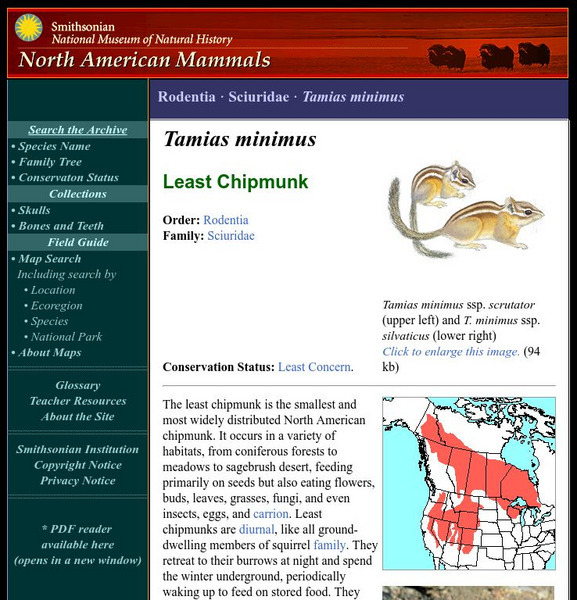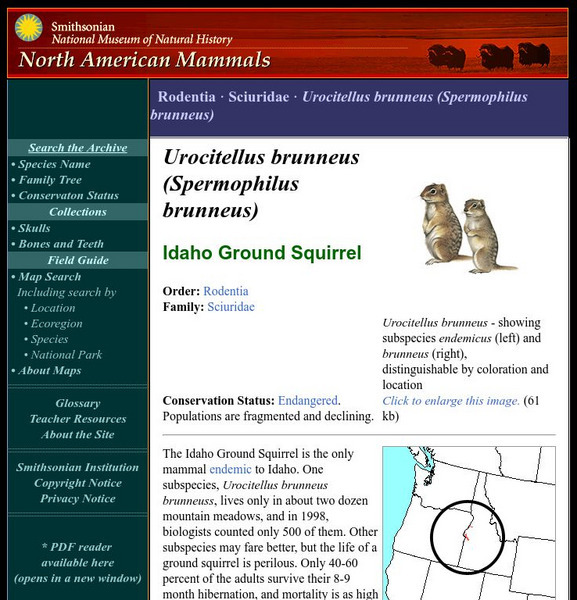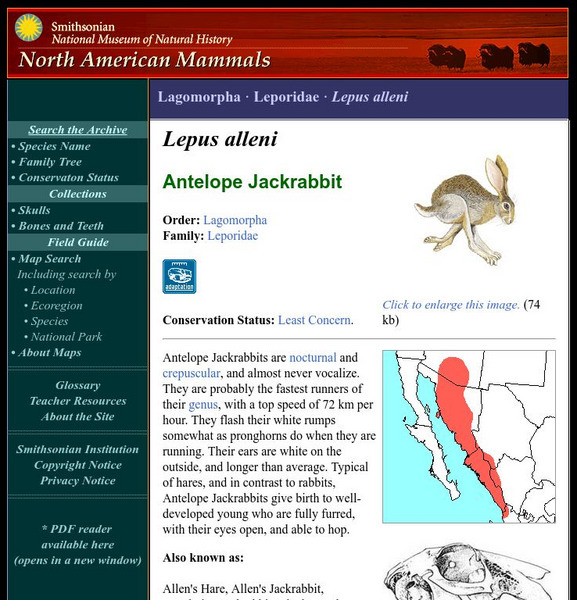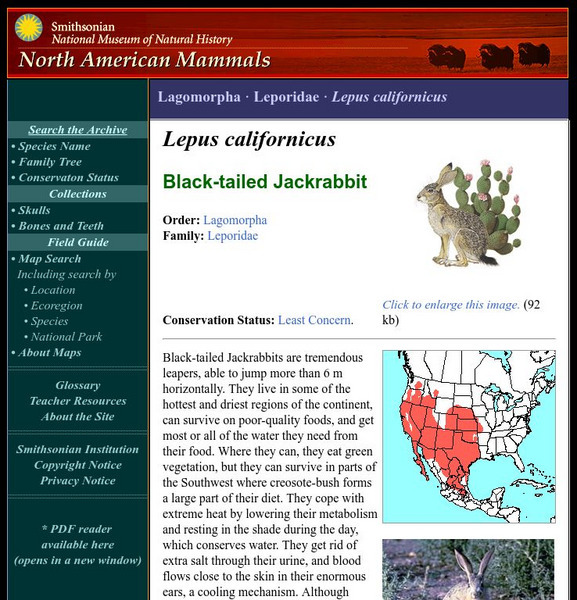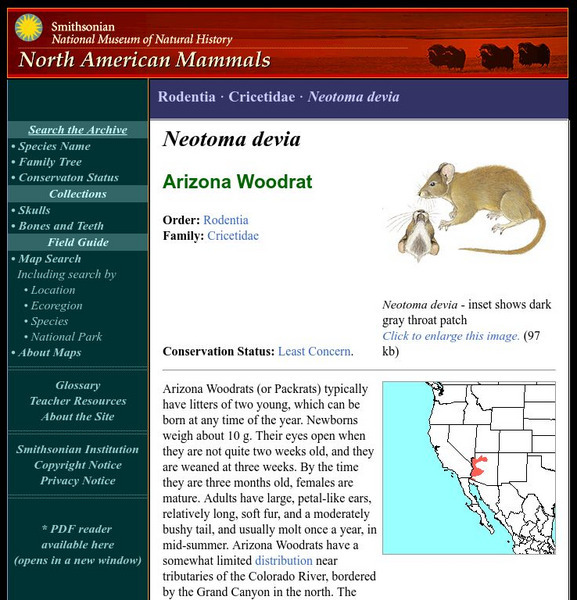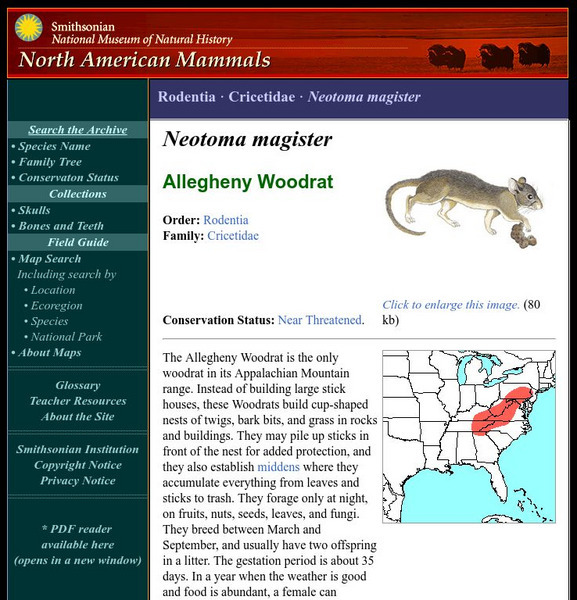Smithsonian Institution
National Museum of Natural History: American Mammals: Island Gray Fox
Island gray foxes are thought to have arrived on three of the six California Channel Islands they now inhabit some 16,000 years ago, either by swimming or by rafting on floating debris. Humans, who first colonized the islands about 6,000...
Smithsonian Institution
National Museum of Natural History: American Mammals: Desert Kangaroo Rat
Desert Kangaroo Rats live in sand dunes in very hot, dry deserts of the southwestern United States, even below sea level in Death Valley, California. They need deep sand for their burrows, and will not dig them in rapidly shifting sand....
Smithsonian Institution
National Museum of Natural History: American Mammals: Dwarf Sperm Whale
The dwarf sperm whale is similar to the pygmy sperm whale, but is smaller and has a larger, taller dorsal fin, higher on its back, that looks like the dorsal fin of a bottlenose dolphin. Dwarf sperm whales live in small social groups....
Smithsonian Institution
National Museum of Natural History: American Mammals: Fraser's Dolphin
Shyness is as good an explanation as any: Fraser's dolphins were first collected as scientific specimens in the 1970s. They are found in tropical waters in many parts of the world but tend to flee from ships. Learn more about the...
Smithsonian Institution
National Museum of Natural History: American Mammals: Least Weasel
The smallest carnivores usually burn energy the fastest and have the most active lifestyles, so it is no surprise that the Least Weasel, the miniature among mustelids, consumes roughly half its body weight each day, equal to about two...
Smithsonian Institution
National Museum of Natural History: American Mammals: Dall's Porpoise
Dall's porpoises are highly acrobatic and are often seen swimming at high speed, darting to and fro, riding the bow waves of boats and engaging in slow rolls at the surface. Because they are black and white, boaters sometimes misidentify...
Smithsonian Institution
National Museum of Natural History: American Mammals: False Killer Whale
For reasons unknown, the false killer whale is among the most common cetaceans involved in mass strandings. The sheer size of these episodes is hard to absorb - 835 animals were beached in the largest documented case. Learn more about...
Smithsonian Institution
National Museum of Natural History: American Mammals: Gray Tailed Vole
One of several voles with very small ranges, Gray-tailed Voles live only in lower-elevation grasslands. They do well in agricultural areas. Learn more about the Microtus canicaudus, more commonly known as a Gray-tailed Vole, in this...
Smithsonian Institution
National Museum of Natural History: American Mammals: Least Chipmunk
The least chipmunk is the smallest and most widely distributed North American chipmunk. It occurs in a variety of habitats, from coniferous forests to meadows to sagebrush desert, feeding primarily on seeds but also eating flowers, buds,...
Smithsonian Institution
National Museum of Natural History: American Mammals: Long Eared Chipmunk
Long-eared chipmunks are striking, with sharp, bright markings and the longest ears of any chipmunk. They live at middle elevations (970-2,290 m) in the Sierra Nevada Mountains. Learn more about the Tamias quadrimaculatus, more commonly...
Smithsonian Institution
National Museum of Natural History: American Mammals: Creeping Vole
Creeping Voles are found in moist coniferous forests at all stages of forest succession, from old growth to recent clear-cuts. In fact, population density is probably higher in recently cut areas where more sunlight reaches the ground...
Smithsonian Institution
National Museum of Natural History: American Mammals: Eastern Small Footed Myotis
The eastern small-footed myotis is one of the smallest North American bats. It has a limited range, occurring only in eastern deciduous and coniferous forests. Learn more about the Myotis leibii, more commonly known as an Eastern...
Smithsonian Institution
National Museum of Natural History: American Mammals: Idaho Ground Squirrel
The Idaho Ground Squirrel is the only mammal endemic to Idaho. One subspecies, Spermophilus brunneus brunneus, lives only in about two dozen mountain meadows, and in 1998, biologists counted only 500 of them. Learn more about the...
Smithsonian Institution
National Museum of Natural History: American Mammals: Hairy Legged Vampire Bat
Vampire bats are amazingly well-equipped to live on a diet of blood and only blood - something no other mammal in the world does. Its teeth are so razor-sharp that the bird or mammal it feeds on usually does not even feel the tiny bite...
Smithsonian Institution
National Museum of Natural History: American Mammals: Eastern Woodrat
Eastern Woodrats are common in wooded areas with dense understories, in hedgerows, and in rocky outcrops. Their dens are occupied by a succession of individuals, each one adding more sticks and other material to the collection. Learn...
Smithsonian Institution
National Museum of Natural History: American Mammals: Dusky Footed Woodrat
Dusky-footed Woodrats, which are really very small rodents, build huge, elaborate houses of sticks. A house can measure more than a meter in diameter and be a meter high and one Woodrat may have as many as three houses. Learn more about...
Smithsonian Institution
National Museum of Natural History: American Mammals: Hispid Pocket Mouse
"Hispid" refers to the coarseness of this pocket mouse's fur. Hispid Pocket Mice are larger and more robust than other pocket mice in their range, and like the others, they are solitary except in the breeding season. Learn more about the...
Smithsonian Institution
National Museum of Natural History: American Mammals: Desert Pocket Mouse
The Desert Pocket Mouse is a common inhabitant of warm deserts throughout the United States and Mexico. It prefers sandy soil and avoids rocky settings, and like other pocket mice, comes out at night to search for seeds. Learn more about...
Smithsonian Institution
National Museum of Natural History: American Mammals: Mexican Long Tongued Bat
Mexican long-tongued bats feed on fruits, pollen, nectar, and probably insects. The populations that summer in the United States migrate to Mexico and northern Central America in winter, following the blooming cycle of plants such as...
Smithsonian Institution
National Museum of Natural History: American Mammals: Virginia Opossum
The Virginia opossum, the only marsupial found north of Mexico, is an adaptable omnivore at home on the ground and in the trees. Opossums prefer forested habitats, but they are quite successful even in urban areas. Learn more about the...
Smithsonian Institution
National Museum of Natural History: American Mammals: Antelope Jackrabbit
Antelope Jackrabbits are nocturnal and crepuscular, and almost never vocalize. They are probably the fastest runners of their genus, with a top speed of 72 km per hour. Learn more about the Lepus alleni, more commonly known as an...
Smithsonian Institution
National Museum of Natural History: American Mammals: Black Tailed Jackrabbit
Black-tailed Jackrabbits are tremendous leapers, able to jump more than 6 m horizontally. They live in some of the hottest and driest regions of the continent, can survive on poor-quality foods, and get most or all of the water they need...
Smithsonian Institution
National Museum of Natural History: American Mammals: Arizona Woodrat
Arizona Woodrats (or Packrats) typically have litters of two young, which can be born at any time of the year. Newborns weigh about 10 g. Learn more about the Neotoma devia, more commonly known as an Arizona Woodrat, in this easy-to-read...
Smithsonian Institution
National Museum of Natural History: American Mammals: Allegheny Woodrat
The Allegheny Woodrat is the only woodrat in its Appalachian Mountain range. Instead of building large stick houses, these Woodrats build cup-shaped nests of twigs, bark bits, and grass in rocks and buildings. Learn more about the...

